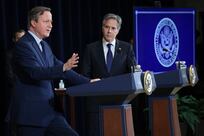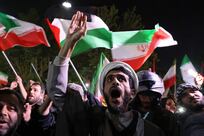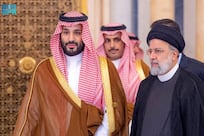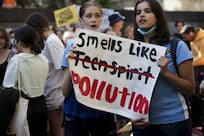For all Tehran’s bravado, there can be little doubt that the new round of US sanctions that come into force on Monday are going to provide a stern test for Iran’s economy.
As part of the US administration's effort to intensify pressure on the regime, a new set of sanctions are due to be imposed on its banking and energy sectors from Monday, in keeping with president Donald Trump's declared aim of reducing oil purchases from Iran to zero.
These are in addition to sanctions the US introduced against Iran in the summer, directed against its currency trade, metals and auto industries, after Mr Trump announced his decision in May to withdraw from the controversial 2015 nuclear deal.
The sanctions imposed so far, together with the prospect of more to come, have already had a calamitous impact on the Iranian economy, with the rial losing an estimated 70 per cent in value this year. This, in turn, has resulted in a dramatic rise in the cost of living, provoking nationwide demonstrations against profiteering and corruption that have taken part in all the main towns and cities. For the first time since the failed Green Revolution of 2009, protesters have chanted anti-government slogans and called for the regime to end costly military interventions in conflicts such as the Syria and Yemen.
The American action is certainly designed to persuade Iran to change tack and to persuade the regime to change its policy of unwelcome meddling in the affairs of neighbouring Arab states. Mr Trump also wants Iran to renegotiate the nuclear deal, which was agreed by his predecessor Barack Obama. The current US administration argues that it does not cover Iran’s ballistic missiles, nor what happens to Tehran’s nuclear programme, which western intelligence agencies believe is designed to produce nuclear weapons once the deal expires in 2025.
The American attitude towards Tehran was best summed up in a tweet sent by US Secretary of State Mike Pompeo earlier this week about the collapse of the Iranian economy. He wrote: “That’s what happens when the ruling regime steals from its people and invests in Assad – instead of creating jobs for Iranians, they ruin the economy.”
In hitting Tehran with a new round of sanctions, the Trump administration is mindful of the salutary effect previous American sanctions have had on the Iranian regime. Washington believes that Iranian President Hassan Rouhani’s election in 2013 was, to a large extent, due to his promise to ease sanctions that had seriously impacted the economy. This, or so the Americans believe, was his primary motive in agreeing to enter negotiations over Iran’s nuclear programme, and gave him the political bandwidth to rally sceptical hardliners around the country’s Supreme Leader, Ayatollah Ali Khamenei, to support the initiative.
It is the hardliners, though, who have wasted the enormous economic benefits that might have accrued once the deal was agreed and the sanctions lifted. Instead of spending the tens of billions of dollars received from the easing of sanctions, Mr Khamenei’s supporters in the Iranian Revolutionary Guard Corps immediately set about investing the proceeds in overseas military adventures, thereby frittering away a valuable legacy.
Now, with the prospect of even more draconian sanctions being imposed next week, senior figures in the regime are desperately trying to persuade sceptical Iranians that they are not to blame.
In quotes published by the state news agency IRNA, Foreign Minister Mohammad Javad Zarif blamed Iran’s economic plight on the Trump administration. “Unfortunately a law-breaking country seeks to punish a country that is abiding by the law. This method will have severe consequences for the world order,” he warned.
A foreign ministry spokesman also took umbrage at Mr Pompeo’s critique, claiming the financing of military operations abroad was not the cause of the economic crisis. “The Iranian economy had shown growth in all previous years when Iran was fighting against the terrorists,” he contended.
The reality, though, is that Iran's economic predicament is about to suffer yet more hardship when the new sanctions bite, despite the efforts being undertaken by Mr Rouhani to explore ways of circumventing the measures. Earlier this week Iranian officials met representatives from Turkey and Azerbaijan to discuss the implications of the sanctions, while officials from the oil ministry insist it will continue to sell crude oil to private companies as part of its strategy to counter the sanctions. The ministry announced 280,000 barrels of oil had already been sold on Iran's energy bourse last week, with another 720,000 barrels soon to be offered for sale on the exchange.
The Iranians will also be looking to exploit the lukewarm response to Washington’s actions from Europe and countries such as China and India, that rely heavily on Iranian oil exports for their own economic wellbeing.
To protect European firms with trade ties with Tehran, the European Union plans to implement a so-called Special Purpose Vehicle (SPV), which it believes will allow them to continue doing business with Iran without being liable to punitive American measures.
Iran will also take heart from comments made by John Bolton, the Trump administration's hawkish national security adviser, who concedes that he does not want the new sanctions to harm America's friends and might consider waivers for friendly countries whose economies depend on Iranian oil supplies.
But Tehran needs to understand that this would only be a temporary measure, one that will not deflect Washington from its ambitious goal of reducing Iran’s oil exports to zero, with all the implications that could have for Iran’s economy.
Con Coughlin is the Daily Telegraph’s defence and foreign affairs editor
__________________
Get stories like this one in your inbox each morning. Sign up for our daily newsletter here





